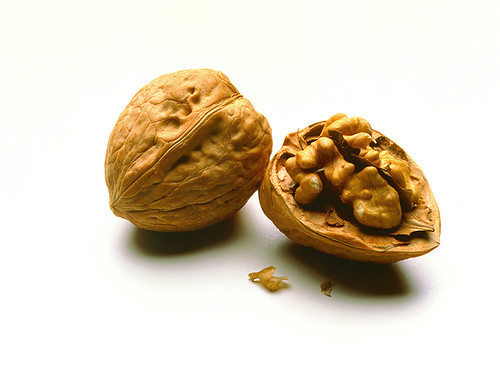
USDA scientists have found that walnuts have 21 percent fewer calories than previously thought, which is good news for the weight-conscious nut lover!
Researchers with USDA’s Agricultural Research Service fed volunteers a controlled diet consisting of walnut halves and pieces (45 grams) for three weeks. After measuring the calories in the walnuts consumed, they found that a typical 28-gram serving actually contains 146 calories, 21 percent fewer than the 185 calories currently assigned by the USDA. The study, published this month in The Journal of Nutrition, was partially funded by the California Walnut Commission.
“The results show that when you can tease out the calories, or the amount of energy, actually absorbed from eating walnuts, the nut is delivering significantly fewer calories than thought,” said David Baer, the research physiologist with the ARS Beltsville Human Nutrition Laboratory who led the study. He added that the findings are consistent with recent studies showing that eating walnuts and other types of tree nuts, as part of a healthy diet, can lead to improved cardiovascular health and a reduced risk of obesity.
The discrepancy found by the researchers could be attributed to evolving methods for calculating calories in foods. Calorie levels listed on labels for walnuts and other tree nuts are based on methods developed in the early 1900s. Scientists in the 1950s grouped walnuts and other tree nuts with other plant-based foods, such as dry beans, legumes and peas, and estimated that each gram of protein or carbohydrate in those foods contained an average of 4 calories of energy, while each gram of fat contained an average of 9 calories.
Baer said the system can work well for estimating calories in mixed diets involving several foods, but not so well for estimating specific calories for certain foods individually, such as tree nuts. Few studies over the years have focused on how individual foods are absorbed by the body, and little scientific data has been collected on tree nuts, he said.
During the past decade, Baer and other researchers have shown that with certain tree nuts, fewer calories are absorbed by the body than the calories contained in other foods. Baer found previously that the number of calories in almonds was 20% less than the standard used for labeling. For pistachios, it was 5% less.
Further studies are needed, but the differences between the calorie levels found in those study results and what appears on the labels could indicate that people don’t completely chew nuts before swallowing them or that it is difficult to fully digest the nut’s cell walls, Baer said.
“We’re just beginning to understand how many foods are absorbed by the body, and nuts are one of the foods now attracting increasing interest,” he said.


